Astronomy on Mars
Chapter 1 Chapter 2 Chapter 3 Chapter 4 Chapter 5 Chapter 6 Chapter 7 Chapter 8 Chapter 91. The Martian Sky

The Environment
The good news:
Imagine you were stargazing on Mars. The conditions on this other world are far better than on Earth. Thin atmosphere, no industrial smog, no light pollution. Further, absense of martian haze, water ice clouds and sand storms provided, there is almost nothing between your scope and the stars. Excellent transparency and seeing makes it possible for the unaided eye to see stars at night as faint as 6.6 magnitudes. In spite of the thin atmosphere and only 43% as bright as on Earth, the Sun's glare prohibits stargazing during the daytime when additionally the sky is often dusty.
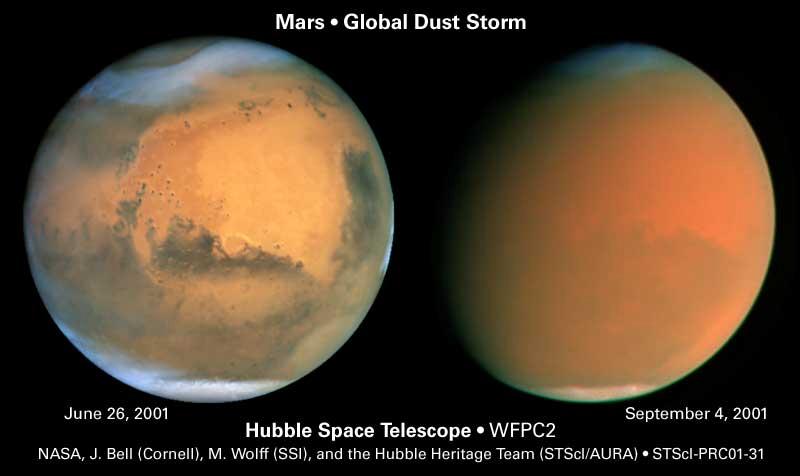
The bad news:
Although the temperature can rise up to +20°C, the average temperature on Mars is -63°C, while the night time temperature can fall below -100°C! The atmosphere is essentially composed of 95.32% carbon dioxid and 7.2% nitrogen. In other words, unbreathable. The average atmospheric pressure is 0.007 bars (about one hundredth of Earth) low in that your body would collaps in seconds. The density of the atmosphere is about one fiftieth of Earth's.
Occasionally, Mars whitnesses giant sand storms which enshroud the entire planet in dust. The thin atmosphere of Mars prohibits strong wind forces even when the wind speeds get very high by Earth standards. NASA's Hubble Space telescope whitnessed a giant dust storm on Mars in 2001.
And for fun:
If your weight on Earth is 75kg, your weight on Mars will be 28.4kg because the gravity of Mars is 0.379 of Earth's. On the other hand, suppose you are 50 earth years old, you would be 26 if you were a Martian. That is because a year on Mars is 1.881 times longer than on Earth.
The Sky
What do the constellations look like on Mars? Would we see our famous Orion and the summer triangle or would we see different figures? No doubt, it would be exciting to see new constellations, however, they are exactly the same. Mars is our neighbor planet in a distance varying between 0.36 and 2.68 average earth-sun distances (AU). The stars lie in distances we use to measure in light-years. The relatively small step to Mars does not make any difference in angular star positions. Even as seen from Pluto, the constellations will still look as if we observed them from Earth.
Due to Mars' different inclination of its equator to its orbit and its orbit to the ecliptic, the north celestrial pole star is not Polaris but near Deneb (Alpha Cygnus) and Alpha Cephei while the brightest star (magnitude 1.9) near the southern pole is delta Velorum, yet well 3° away from the south celestrial pole.
Consequently, Mars has no exact pole stars (just like Earth). The coordinates for 1 January 2000 are R.A. 21h10m43" and declination 52°53"09" for the north pole and 9h10m43" (north pole minus 12 hours) and -52°53"09" for the south pole. Just like the tips of the Earth axis wobble as a result of precession and nutation, so does the axis of Mars, in that the exact polar celestial coordinates change slightly over time. The small moons of Mars have no stabilizing effect on Mars in that the variation of Mars"s axial tilt is much larger than for Earth.
Inspite of the unchanged constellations, a Mars observatory will see a few significant changes. These include the close asteroid-like moons of Mars, the bright inner "double-planet" Earth as a morning or evening star, the smaller size of the Sun, the different sizes and brightnesses of the other planets, the much closer dwarf planet Ceres, asteroid Vesta, appearance of meteors, cosmic rays and more.
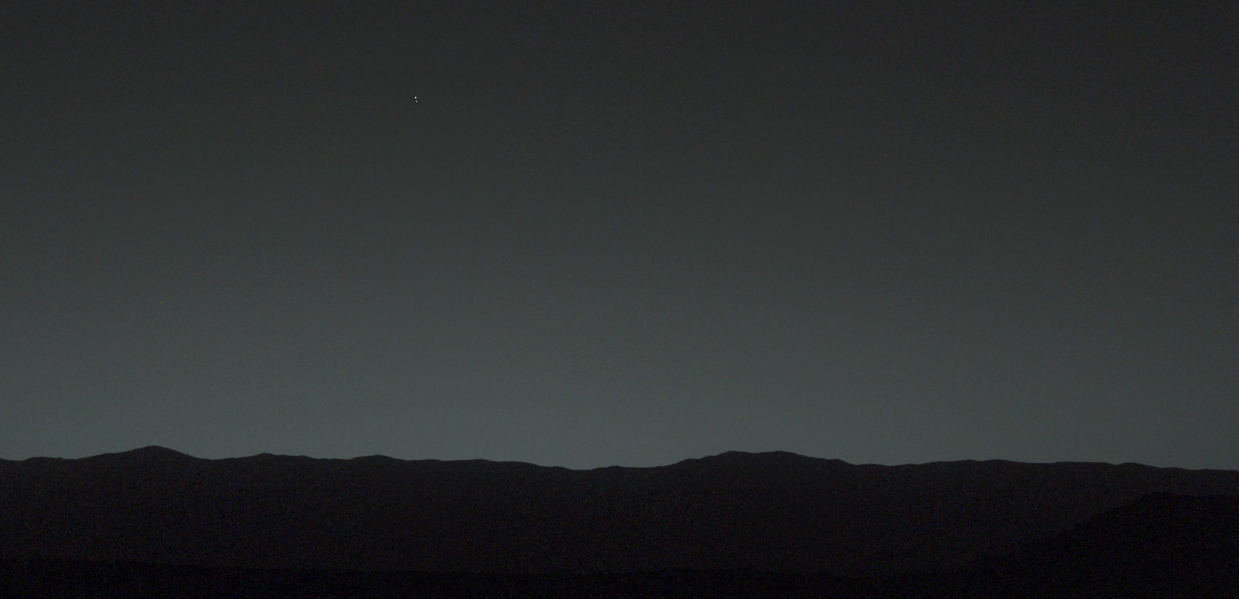
Researchers used the left eye camera of Curiosity's Mast Camera (Mastcam) to capture this scene about 80 minutes after sunset on the 529th Martian day, or sol, of the rover's work on Mars (Jan. 31, 2014). The image has been processed to remove effects of cosmic rays. The Earth and Moon dots have been brightened up to about twice the brightness recorded by the camera. A human observer with normal vision, if standing on Mars, could easily see Earth and the moon as two distinct, bright "evening stars." The distance between Earth and Mars when Curiosity took the photo was about 99 million miles (160 million kilometers).
Image Credit: NASA/JPL-Caltech/MSSS/TAMU
2. Martian Moons from Mars
Martian System
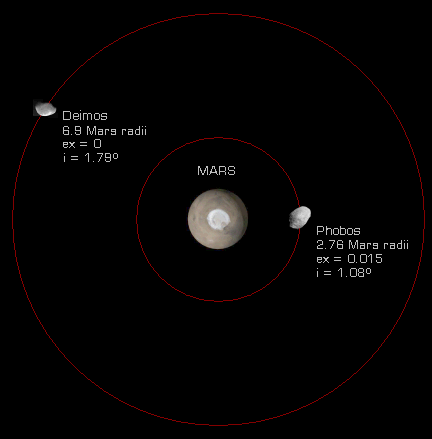
Most apparently, there is no large, bright moon like ours. Mars has two natural satellites, the inner moon Phobos (Greek for 'fear') and the outer moon Deimos (Greek for 'panic'). Both are not round like our moon. They look more like asteroids or oblong, potato shaped rocks that may have been snared by Mars' gravity now performing as moons. Phobos lies 9,400km away from Mars' center while Deimos is 23,500km away. Since the eccentricity of Deimos is zero, it orbits at an almost constant distance and velocity. Phobos' eccentricity is comparable to that of Earth nearing Mars at a rate of 1.8 meters every hundred years; at that rate, in 50 million years, it will either crash into Mars or break up into a ring.
Left: View onto North of the orbits of the martian moons drawn to scale. The sizes of the moons are much exaggerated. ex is the orbit eccentricity, i the orbit inclination to Mars's equator. The distance from the core of Mars is given in Mars radii.
Phobos

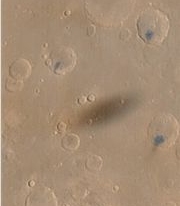
Phobos orbits Mars three times a day (once in 0.32 earth days) in a low-inclination equatorial orbit and is so close to the planet's surface that it cannot be seen in locations on Mars over 70° northern or southern latitudes. The moon rises in the west and sets in the east (reverse apparent motion) because it orbits Mars three times faster than the planet rotates around its axis. The time between two meridian transits is about 11.11 hours while the duration of visibility lasts 4.24 hours on the equator and over 5 hours on ±65° latitudes. Phobos rotates around its axis in the same time as it orbits Mars. The moon is therefore tidally locked and shows Mars always the same face, just like our Moon and many other planetary moons.
Given its size (27 by 22 by 18 km) and distance to Mars' surface (5980 km on the equator), Phobos apparent size is 1/2 of the moon across its longest axis, large enough to spot its most significant impact crater known as "Stickney" with the unaided eye. Due to the additional distance observers on higher latitudes will see a smaller moon. Actually, due to its close proximity to Mars' surface, Phobos' apparent size varies by up to 45%! The apparent visual magnitude is around -9mv, 1/30 as bright as our full moon.
Just like our Moon casts a shadow during a solor eclipse the penumbral shadow of Phobos during a Martin eclipse has been photographed by the Mars Global Surveyor on August 26, 1999 as it cast upon western Xanthe Terra at about 2 p.m. local time on Mars. The image covers an area about 250 kilometers (155 miles) across and is illuminated from the left.
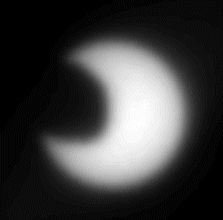
Whitnessed by Mars Rover Opportunity, Phobos transits the Sun on March 10, 2004.
If you could stand on Mars and watch Phobos passing overhead, you would notice that this moon appears to be only about half the size of what Earth's Moon looks like when viewed from the ground. In addition, the Sun would seem to have shrunk to about 2/3 of its size as seen from Earth. Martian eclipses are therefore dark but not as spectacular as total solar eclipses on Earth.

Opportunity captured Phobos' entire silhouette eclipsing the Sun on March 10, 2004.
Since the tiny moons orbit very close to the planet surface, the martian eclipses are thousands of times more common, occuring a few times a day somewhere on Mars whenever Phobos passes over the planet's sunlit side. A transit of Phobos from Mars usually lasts only thirty seconds, due to its very rapid orbital period of about 7.66 hours.
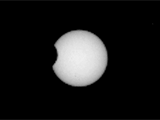
Phobos in transit as observed by MSL Curiosity on Sep 13, 2012.
The event was observed on Martian day, or sol, 37 (September 13, 2012) using Curiosity's Mast Camera, or Mastcam, equipped with special filters for directly observing the sun. In a series of high-resolution video frames acquired at about three frames per second for about two minutes, the outline of part of Phobos blocked about five percent of the sun.
Deimos
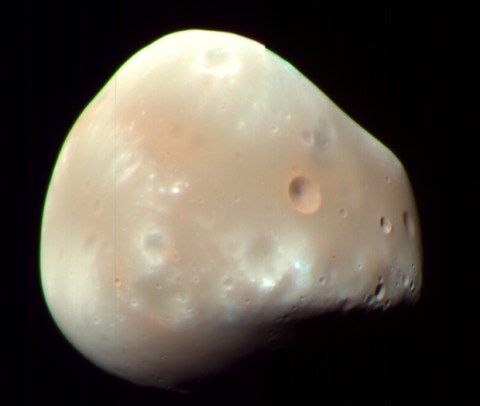
As seen from Mars, the outer moon Deimos appears between 1.8 and 2.6 arc minutes wide because it lies further out 20,060 km from the surface on the equator and is smaller than Phobos, namely 15 by 12 by 11 km across. It circles Mars in 30.3 hours and shines at maximum -5.5 visual magnitude, brighter than Venus.
Because it exceeds the martian rotation of 24.6 hours, Deimos rises in the east and sets in the west. It transits the meridian every 131 hours (5.5 days) while it takes 59.5 hours (2.5 days) between rising and setting on the equator or 64.6 hours (2.7 days) at 80° northern or southern latitides. Although over 3 times further out than Phobos, Deimos cannot be observed at martian latitudes higher than ±82 degrees. Interestingly, Deimos is tidally locked to Mars as Phobos is.
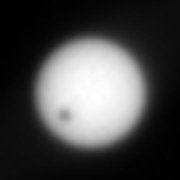
This image shows the passing, or transit, of the martian moon Deimos over the Sun. Taken by Mars Exploration Rover Opportunity on sol 39 of its mission. NASA/JPL/Cornell.
Occultations
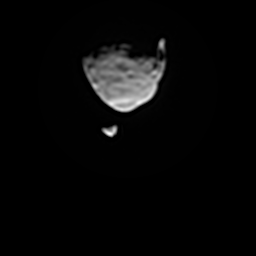
This movie clip shows the larger of Mars' two moons, Phobos, passing in front of the smaller Martian moon, Deimos, as observed by NASA's Mars rover Curiosity. The series of 41 images is shown at increased speed. The actual elapsed time is 55 seconds. The images were taken by the telephoto-lens camera of the Mast Camera pair (right Mastcam) on Curiosity on Aug. 1, 2013, during the 351st Martian day, or sol, of Curiosity's work on Mars. These observations of Phobos and Deimos help researchers make knowledge of the moons' orbits even more precise. On Phobos, Stickney Crater is visible on the bottom. It is on the leading hemisphere of Phobos. Hall Crater, in the south, is the prominent feature on the right hand side.
Image Credit: NASA/JPL-Caltech/Malin Space Science Systems/Texas A&M Univ.
Apparent Sizes of the Moons
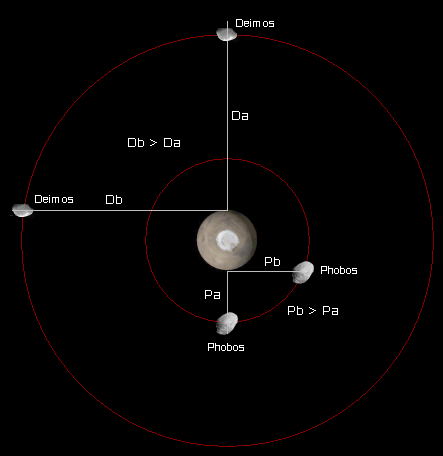
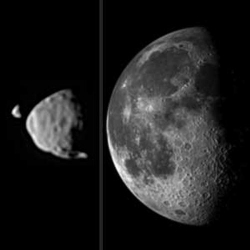
Depending on a moon's orbit position relative to an observer the distance and therefore the angular sizes during a moon orbit period varies. The illustration shows the observer on the equator of Mars, however, when moving to higher latitudes the distances grow further as a result of the additional angular distance from the equator.
 This illustration demonstrates the effect of the observer's latitude. This phenomena is common to all moons in the solar system, however, it is more apparent with closely orbiting moons.
This illustration demonstrates the effect of the observer's latitude. This phenomena is common to all moons in the solar system, however, it is more apparent with closely orbiting moons.
Let's create a model shrinking Mars and its tiny moons to a far smaller scale. If Mars were the size of a basketball (25 cm or 10 inches) in diameter, Phobos would be a grain 1mm across and 34.5cm away from the basketball (Mars), while Deimos measures 0.55mm and is 86.3cm away. Probably it would be hard to pinpoint the moons. In true space, other "grains" are much farther away while Phobos and Deimos are the brightest objects in the sky next to the Sun.
3. Mars from its Moons
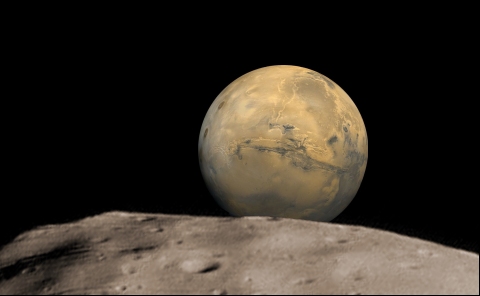 A simulated view from Phobos facing Valles Marineris. The field of view is 120°. Mars mosaic image captured by Viking 1 on February 22, 1980.
A simulated view from Phobos facing Valles Marineris. The field of view is 120°. Mars mosaic image captured by Viking 1 on February 22, 1980.
Now let's travel to the Martian moons to view Mars. As you already imagine Mars will be huge in the sky due to the proximity of both moons. If you could stand on Phobos you would see Mars 42.5° wide - 85 times the full Earth moon.
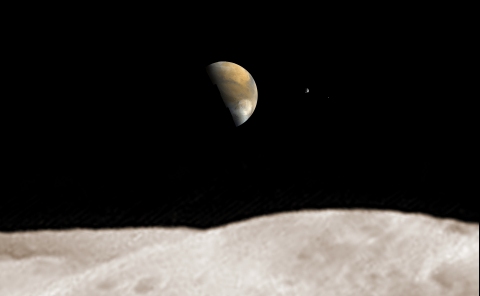 A simulated view from Deimos facing the Hellas Area. The field of view is 120°. Mars mosaic image captured by Viking 1 on July 7, 1980.
A simulated view from Deimos facing the Hellas Area. The field of view is 120°. Mars mosaic image captured by Viking 1 on July 7, 1980.
Likewise, from Deimos, Mars is still 16.7° in diameter - over 33 times the full Earth moon. From both martian moons, this is a fantastic view. Reflected light from Mars' red surface will provide stunning Mars shine on the night side of both moons. Our moon, too shines onto Earth but by different standards and less spectacular.
4. Phobos from Deimos and Back
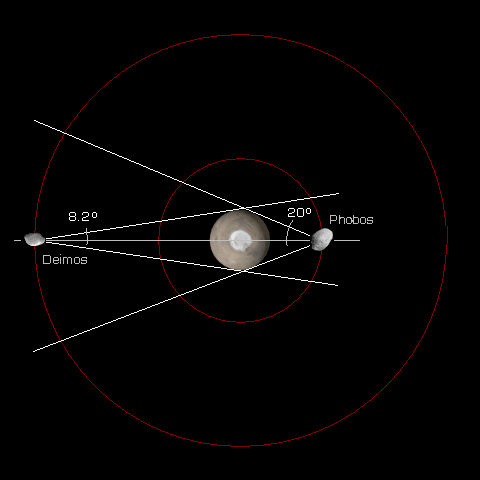
Assuming we could stand on Phobos to watch Deimos or on Deimos to gaze at Phobos we would expect a performance of fast changes, because we know that both moons are rapid orbiters. Probably, we would have more fun on Deimos watching Phobos swing around Mars three times a day.
How big we see Phobos from Deimos is a matter of distance which can vary between 14,081km when Phobos is between Mars and Deimos and 32,837km when Phobos is behind Mars. At shortest distance Phobos would appear 6.59 arc minutes wide and 2.83 arc minutes at farest distance. In comparison, Deimos as seen from Phobos would appear 3.66 and 1.57 arc minutes, respectively.
Now the problem with small bodies closely orbiting the comparitively large planet Mars at low inclination is that you can't see either Phobos or Deimos at all times. From the short distance of Phobos, Mars is a big guy to hide behind. In fact, Deimos cannot be seen from Phobos unless its eastern or western elongation from Mars exceeds 20°. Deimos is further out and requires that Phobos elongates over 8° east or west. Basically, these are the angular radii of Mars as seen from each moon.
5. Stargazing on Mars
Instrumentation
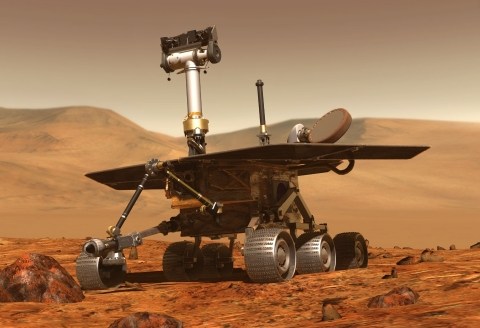 Mars Rover "Spirit".
Mars Rover "Spirit".
Taking advantage of extra solar energy collected during the day, NASA's Mars Exploration Rover Spirit settled in for an evening of stargazing with its panoramic cameras, photographing the two moons of Mars as they crossed the night sky.
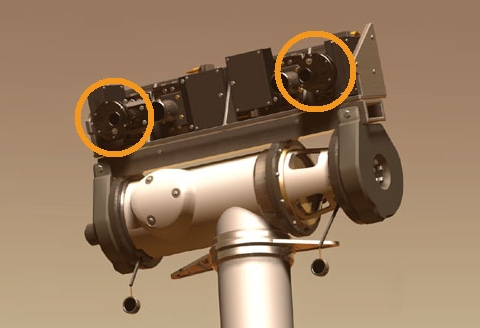 Spirit's two panoramic CCD cameras
Spirit's two panoramic CCD cameras
The two identical cameras are equipped with a 38mm (focal ratio f/20) lens matched to a 1024 by 1024 pixels CCD yielding a 16.8° field of view, consequently a resolution of ca. 59 arc seconds per pixel. This field resembles a conventional 35mm SLR with a 125mm lens.
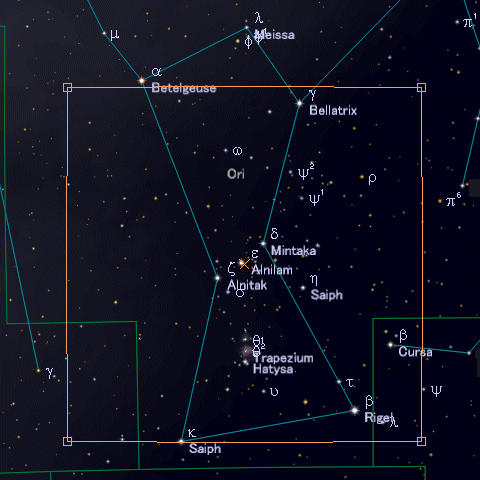 The orange frame marks the 16.8° x 16.8° field of view of Spirit's CCD cameras against the popular constellation Orion. Generated with AstroArts StellaNavigator7.
The orange frame marks the 16.8° x 16.8° field of view of Spirit's CCD cameras against the popular constellation Orion. Generated with AstroArts StellaNavigator7.
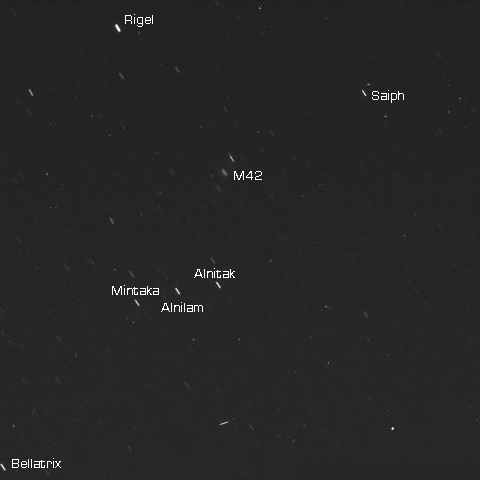 Spirit's March 11, 2004 image of Orion.
Spirit's March 11, 2004 image of Orion.
Spirit's pancam took this image of Orion with a 60 seconds exposure from Columbia Hills, Gusev Crater. The field of view confirms the simulated view above. Orion is "upside down" because the Gusev crater is situated some 15 degrees south of Mars's celestial equator.
Spirit's location projected on Earth is a point 300 km west off Samoa's coast in southern hemisphere. On Mars, Orion lies completely south of the celestial equator, while Earth's equator passes near the star Mintaka in Orion's belt splitting Orion into a northern and a southern part.
The field of view of a camera configuration depends on the size of film or CCD chip and the focal length of the lens. The FOV is mathematically obtained by:
φ = Atn(x/fl)where...
x = length or width of film or CCD [mm]
fl = focal length of the lens [mm]
Example:
φ = Atn(36/120)
φ = 16.7°
Focal length required for popular CCDs to obtain a field of about 16° wide:
Watec 120 Neptune: 22mm
Pentax istD*, Nikon D70: 80mm
Near Miss With Mars
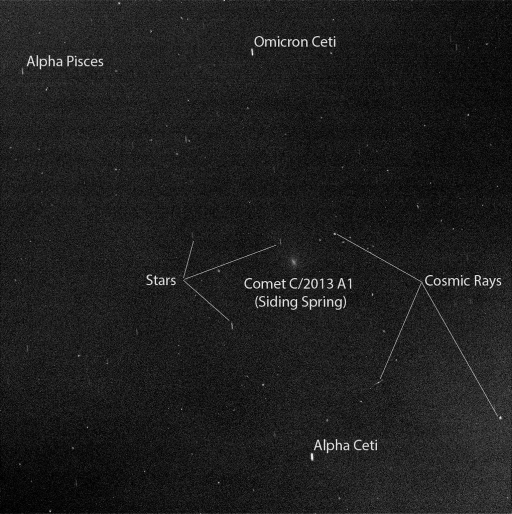
Researchers used the panoramic camera (Pancam) on NASA's Mars Exploration Rover Opportunity to capture this view of comet C/2013 A1 Siding Spring as it passed near Mars on Oct. 19, 2014. This image is from a 50-second exposure taken about two-and-a-half hours before the closest approach of the comet's nucleus to Mars. The sky was still relatively dark, before Martian dawn. At the time of closest approach, the morning sky was too bright for observation of the comet. The comet, some nearby stars, and some effects of cosmic rays hitting the camera's light detector are labeled.
The image has been processed by removal of detector artifacts and slight twilight glow. The duration of the exposure resulted in a 12.5-pixel smear from rotation of Mars. The smear for the comet is at a slightly different angle from the others, due to the comet's own motion across the sky.
A Martian dust storm to the west of Opportunity hampered visibility somewhat on Oct. 19, compared to the sky over Opportunity a week earlier.
Discovered on January 3, 2013, C/2013 A1 (Siding Spring) is an up to 3km wide comet coming from the Oort Cloud along a roughly 1-million-year orbit. On October 19, 2014 at 18:28UT, the comet passed Mars at a speed of 56km/s within 139,500km (84,000 miles), which is about a third of the Moon's distance from Earth and less than one-tenth the distance of any known comet flyby of Earth. The comet will made its closest approach to our Sun on October 25, 2014, at a distance of 130 million miles, well outside Earth's orbit.
Observations
With the altazimuth mount fixed on a US$400 million rover, this is a quite formidable observatory running under remote control on another world.
Tracking of the sky for long exposures was not intended per Spirit's job description because the cameras are provided for the purpose of
photographing martian soils. Nevertheless, the results are manifold and remarkable.
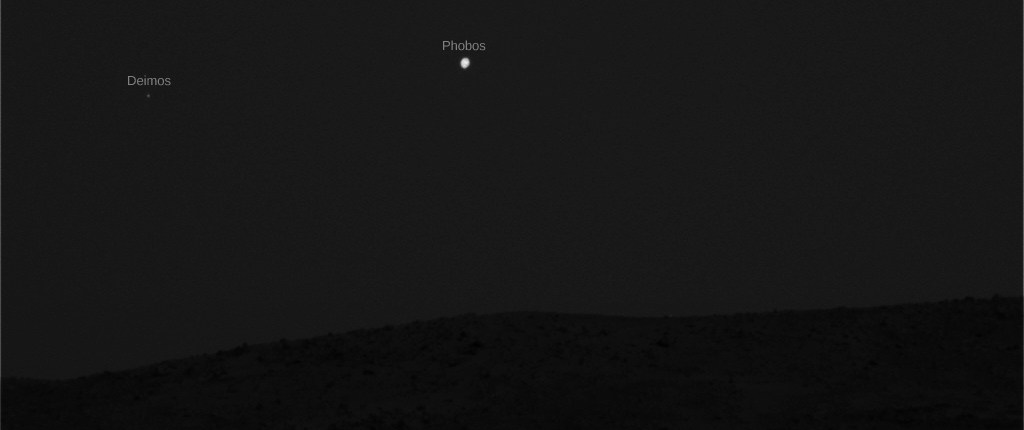 Image credit: NASA/JPL/Cornell/Texas A&M
Image credit: NASA/JPL/Cornell/Texas A&M
Phobos rising and Deimos setting just above the horizon in the west in the pre-dawn hours of Spirit's Sol 682 (Dec. 3, 2005). Remember that Phobos orbits 3 times faster than Mars rotates, in that Phobos rises in the west and sets in the east. Deimos orbits in less time than a planet rotation, therefore rising and setting 'normally'.
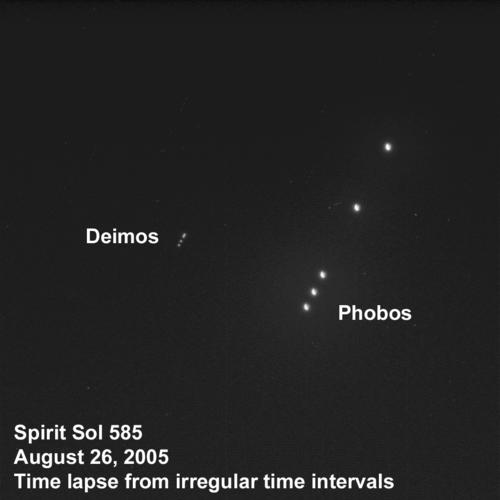 Image credit: NASA/JPL/Cornell/Texas A&M
Image credit: NASA/JPL/Cornell/Texas A&M
This time-lapse composite, acquired the evening of Spirit's martian sol 585 (Aug. 26, 2005) from a perch atop "Husband Hill" in Gusev Crater, shows Phobos, the brighter moon, on the right, and Deimos, the dimmer moon, on the left. Tiny streaks mark the trails of background stars moving across the sky or the impact of cosmic rays lighting up random groups of pixels in the image.
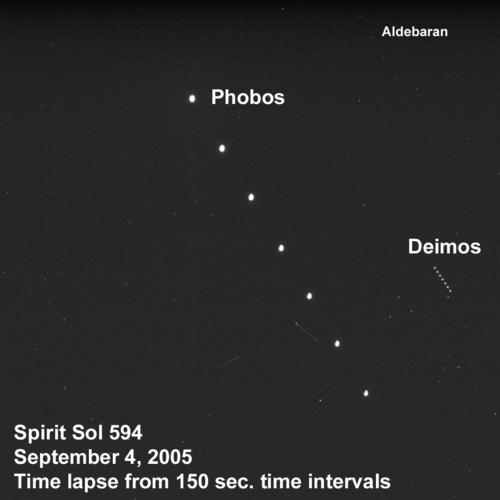 Image credit: NASA/JPL/Cornell/Texas A&M
Image credit: NASA/JPL/Cornell/Texas A&M
Spirit took this succession of images at 150-second intervals from a perch atop "Husband Hill" in Gusev Crater on martian day, or sol, 594 (Sept. 4, 2005), as the faster-moving martian moon Phobos was passing Deimos in the night sky. Phobos is the brighter object on the left and Deimos is the dimmer object on the right. The bright star Aldebaran and some other stars in the constellation Taurus are visible as star trails. Most of the other streaks in the image are the result of cosmic rays lighting up random groups of pixels in the camera.
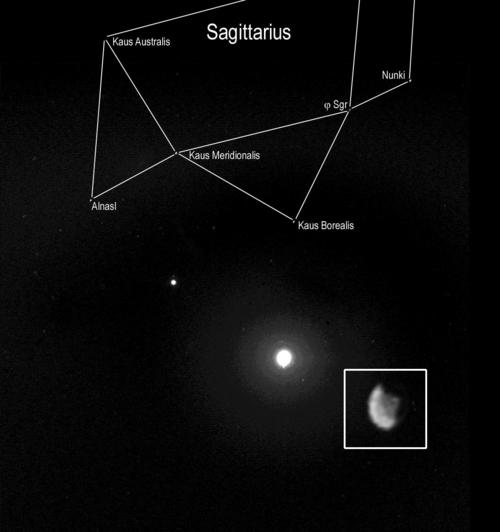 Image credit: NASA/JPL/Cornell/Texas A&M
Image credit: NASA/JPL/Cornell/Texas A&M
In this image, both martian moons, Deimos on the left and Phobos on the right, travel across the night sky in front of the constellation Sagittarius which in part resembles an upside-down teapot. In this view, Phobos moves toward the handle and Deimos moves toward the lid. Each of the stars in Sagittarius is labeled with its formal name. The inset shows an enlarged, enhanced view of Phobos, shaped rather like a potato with a hole near one end. The hole is the large impact creater Stickney, visible on the moon's upper right limb. Spirit acquired these enhanced-brightness images on the night of sol 585 (Aug. 26, 2005).
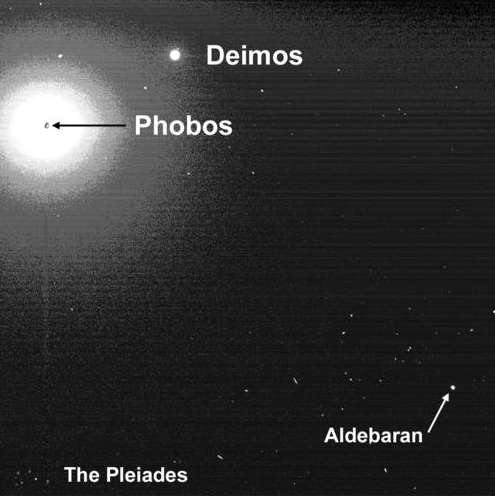 Image credit: NASA/JPL/Cornell/Texas A&M
Image credit: NASA/JPL/Cornell/Texas A&M
In this view the Pleiades, a star cluster also known as the "Seven Sisters," is visible in the lower left corner. The bright star Aldebaran and some of the stars in the constellation Taurus are visible on the right. Spirit acquired this image the evening of martian day, or sol, 590 (Aug. 30, 2005). Within the enhanced halo of light is an insert of an unsaturated view of Phobos taken a few images later in the same sequence.
Scientists will use images of the two moons to better map their orbital positions, learn more about their composition, and monitor the presence of nighttime clouds or haze. Spirit took the five images that make up this composite with the panoramic camera, using the camera's broadband filter, which was designed specifically for acquiring images under low-light conditions.
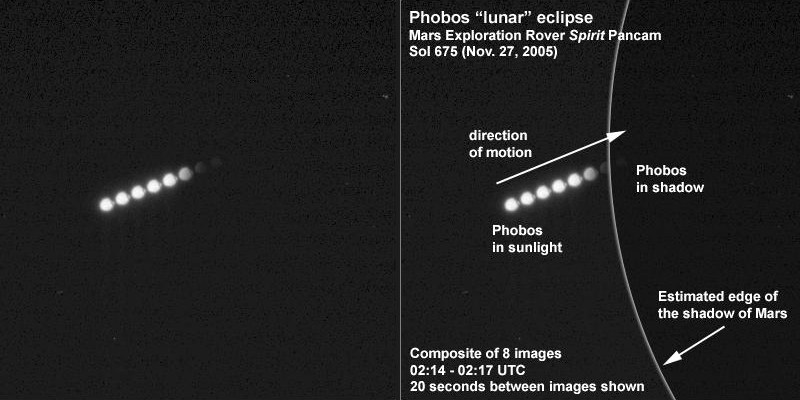
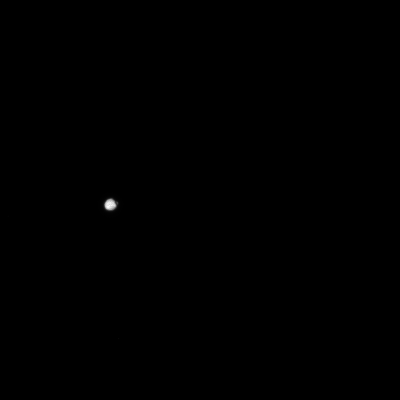 Image credit: NASA/JPL-Caltech/Cornell/Texas A&M/SSI
Image credit: NASA/JPL-Caltech/Cornell/Texas A&M/SSI
NASA's Mars Exploration Rover Spirit observed the Martian moon Phobos entering the shadow of Mars during the night of the rover's 675th sol (Nov. 27, 2005). The panoramic camera captured 16 images, spaced 10 seconds apart, covering the period from when Phobos was in full sunlight to when it was entirely in shadow. As with our own Moon during lunar eclipses on Earth, even when in the planet's shadow, Phobos was not entirely dark. The small amount of light still visible from Phobos is a kind of "Mars-shine" -- sunlight reflected through Mars' atmosphere and into the shadowed region.
This view is a time-lapse composite of images taken 20 seconds apart, showing the movement of Phobos from left to right. (At 10 seconds apart, the images of the moon overlap each other.) Scientists are using information about the precise timing of Martian moon eclipses gained from observations such as these to refine calculations about the orbital path of Phobos. The precise position of Phobos will be important to any future spacecraft taking detailed pictures of the moon or landing on its surface.
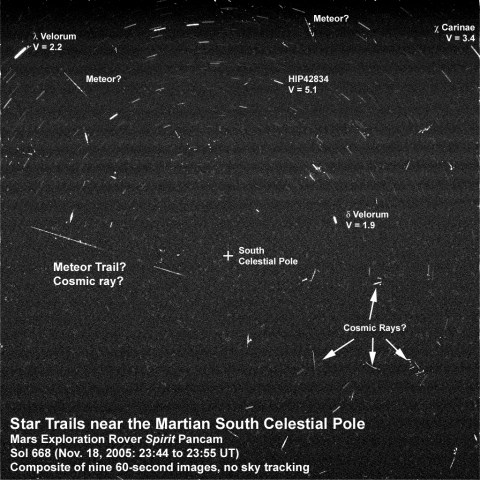 Image credit: NASA/JPL/Cornell/Texas A&M
Image credit: NASA/JPL/Cornell/Texas A&M
On October 25, 2005, Spirit imaged the southern celestial pole of Mars with a composite of nine 60 second untracked exposures. The image shows several trails and marks that could stem from meteors or cosmic rays. While meteor trails often draw a similar direction from a common point of origin, cosmic rays travel from all directions. These high energy particles are generated by the Sun and other stars, annoyingly for amateur images, but of high value for scientific purposes to predict the rate and intensity of cosmic rays striking Mars, knowledge of which gives clues on water ice and dust cloud concentrations during martian nights.
6. Earth from Mars
Earth is an inner planet
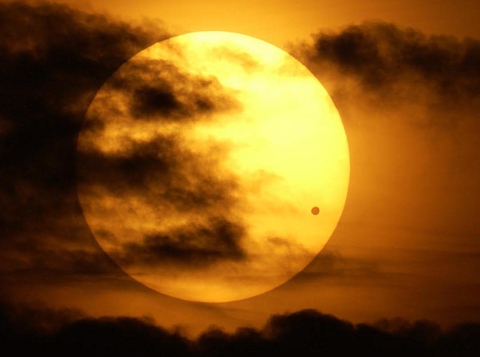 Venus transit in 2004 imaged on Earth, continent North America. Courtesy K. Spencer.
Venus transit in 2004 imaged on Earth, continent North America. Courtesy K. Spencer.
While the constellations over Mars are the same, the positions of the planets are much different from the vantage point of Mars.
When observing the solar system planets from Earth we see two inner planets - Mercury and Venus. Mars adds a further inner planet - the Earth - which, as seen from Mars, has the largest elongation (46° at greatest elongation, Mars at perihelion) from the Sun because its orbit is wider than that of Venus and Mercury. As with all inner planets Earth shows phases from 0 to 180 degrees, just like the phases of Venus we observe from Earth.
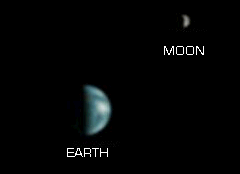
On Mars, Earth and the Moon would appear as a naked eye double-planet. Since Earth is an inner planet like Venus (a "morning star" or "evening star") observers on Mars can rarely view transits of Earth across the Sun. The next transit is predicted for November 10, 2084, the last transit occurred on May 11, 1984. The image above shows the transit of Venus on June 8, 2004. If Venus were Earth and imaged on Mars, Earth's disk passing in front of the Sun would exhibit nearly the same size with the difference being that the Sun is only 2/3rd wide.
Earth of the Past
As when we watch planets from Earth we are looking into the past when we observe Earth from Mars. That is because the light from a planet travels over hundreds of millions kilometers, while the speed of light is near 300,000 kilometers per second. Pluto is over 39 AU out there at the edge of the Solar System. The light from Pluto then takes over five hours to reach us. Consequently, we observe Pluto as it was over five hours ago. Now, Earth won't get that far away from Mars, yet it's light takes several minutes. The actual time depends on the distance and can vary roughly between 3 and 22 minutes. The light from the Sun travels 12.7 minutes to Mars at average distance.
 The difference the light time makes when observing Earth from Mars.
The difference the light time makes when observing Earth from Mars.
Let's assume a 'worst case'. Earth is 22 light minutes away from Mars. You slew your large telescope pinpoint on Earth and find that Tokyo lies straight underneath the central meridian. Behold, what you see is what was 22 minutes ago. Earth rotates once in 24 hours or 360° around from west to east. In other words, 1° in 4 minutes. During an interval of 22 minutes Earth rotates 5.5° towards east. Therefore, whilst you see Tokyo in the center, the real central meridian crosses over Okayama and Shikoku, over 500 km in the west on that latitude (35° north). Of course, the same phenomena is experienced when observing the planets from Earth. Astronomy software usually compensates for the light time presenting the central meridian as if viewed through a telescope -- on Earth.
Close Approaches
Depending on each other's orbit positions, the distance between Mars and Earth can vary between 0.36 and 2.68 AUs. Every 2.2 years the two planets near to a close approach. The closest approach since some 60,000 years occured in August 27 in 2003 shrinking the inter-planetary distance to mere 55.758 million km (0.37319AU) at 09:51 UTC (or 3.1 light minutes). While we observed Mars fully illuminated, an observer on Mars would see a dark Earth because the Sun, Earth and Mars are straight aligned, with the Sun shining behind Earth as seen from Mars (orbital inclinations to the ecliptic ignored).
Specifically, at this event, Earth showed Mars its Pacific Ocean at night from its location in the center of the constellation Leo. While Mars was 25.1 arc second wide in Aquarius, the apparent size of Earth from Mars was nearly twice wider, namely 47.13 arc seconds - the scale of a close Jupiter seen from Earth. This is simply due to Earth's diameter, which is about twice of Mars's.
7. Sunsets on Mars
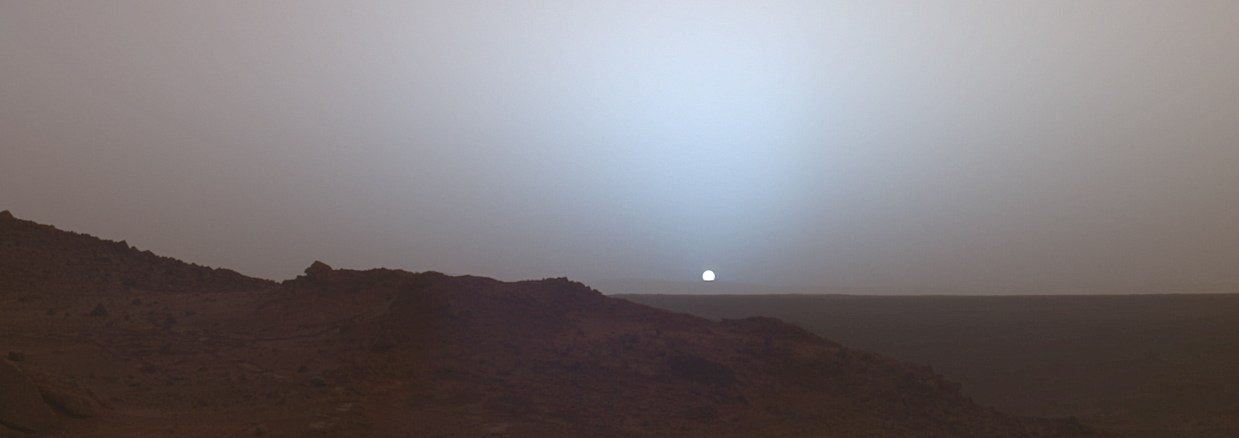 NASA/JPL-Caltech
NASA/JPL-Caltech
On May 19th, 2005, NASA's Mars Exploration Rover Spirit captured this stunning view as the Sun sank below the rim of Gusev crater on Mars. This Panoramic Camera (Pancam) mosaic was taken around 6:07 in the evening of the rover's 489th martian day, or sol. Spirit was commanded to stay awake briefly after sending that sol's data to the Mars Odyssey orbiter just before sunset. This small panorama of the western sky was obtained using Pancam's 750-nanometer, 530-nanometer and 430-nanometer color filters. This filter combination allows false color images to be generated that are similar to what a human would see, but with the colors slightly exaggerated.
In this image, the bluish glow in the sky above the Sun would be visible to us if we were there, but an artifact of the Pancam's infrared imaging capabilities is that with this filter combination the redness of the sky farther from the sunset is exaggerated compared to the daytime colors of the martian sky. Because Mars is farther from the Sun than the Earth is, the Sun appears only about two-thirds the size that it appears in a sunset seen from the Earth. The terrain in the foreground is the rock outcrop "Jibsheet", a feature that Spirit has been investigating for several weeks (rover tracks are dimly visible leading up to Jibsheet). The floor of Gusev crater is visible in the distance, and the Sun is setting behind the wall of Gusev some 80 km (50 miles) in the distance.
Text courtesy NASA/JPL-Caltech
8. Ancient Mars
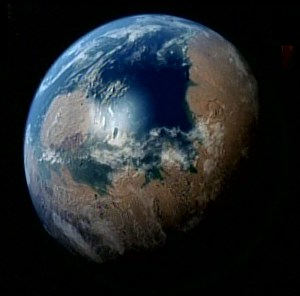 A speculative view of the early Mars.
A speculative view of the early Mars.
Some 4 billion years ago, when Earth was still completely covered by oceans, the surface of Mars was probably covered by both, oceans and land masses with rivers and primitive sea fauna and flora. A planet covered entirely by water can hardly develop lifeforms. Cohesion of organic matter in water is difficult, because organic matter connects by means of water molecules attached to it and separate upon cohesion. This hardly works in pure water.
Meanwhile, it was easier for Mars, with its oceans and continents to support life long before Earth. Rivers on land flow and dry out repeatingly. In dry environments and in absense of water, organic matter can grow. If that was the case with Mars, life could have been brought from Mars to Earth, for instance by asteroid impacts that whirled up rocks carrying organic matter into space that headed for Earth and felt into its ocean.
Comets are known to carry organic matter and did impact on both Mars and Earth. On Earth, comets felt into the ocean while Mars provided the more favorable environment to bring up life before continents formed on Earth.
The composition of Mars' atmosphere, axial tilt, sun distance, etc., at that time is unknown and will probably remain unknown, in that this chapter is speculative.
9. Some Mars Maths
1. Weight and Age
Your weight on Mars is your weight on Earth multiplied by 0.379, while your age on Mars is your age on Earth divided by 1.881.2. Elongation of Earth
Elongation is the angular distance of an inner planet to the Sun. Earth as observed from Mars is an inner planet. The mean greatest elongation of Earth is obtained by:el = Asin(aE/aM) [°]
where...
aE = semi-major axis of Earth [AU]
aM = semi-major axis of Mars [AU]
consequently:
el = Asin(1 / 1.5237) = 41°
Both, Mars and Earth travel on eccentric orbits taking them through closest (perihelion) and farest (aphelion) points. The maximum greatest elongation of Earth occurs when Mars is in perihelion and Earth in its aphelion: 47.4° (Asin(1.0167/1.3814AU)) forming a right angle with the Sun. In the vice-versa case Earth is observed at minimum greatest elongation: 36.2° (Asin(0.9833/1.666AU)). That is a difference of 11.2°, however, such constellations are theoretical.

For comparison the mean maximum elongations of inner planets from Mars and Earth:
| Mars | Earth | |
|---|---|---|
| Earth | 41.0° | -/- |
| Venus | 28.3° | 46.0° |
| Mercury | 14.7° | 22.8° |
An extreme case is Mercury's greatest elongation of 0.56° as seen from Pluto at its mean distance from the Sun -- hopelessly lost in the glare.
3. Interval between two Meridian Transits
The time between two meridian transits of the martian moons can be obtained by knowlegde of the axial rotation period of Mars (p = 1.026 days) and orbit period of a moon (Phobos: pm = 0.319 days, Deimos: pm = 1.263 days):mt = 1 / (1 / p - 1 / pm) [days]
for Phobos:
mt = 1 / (1 / 1.026 - 1 / 0.319)
mt = -0.463 days or -11.11 hours
If negative the moon rises in the west and sets in the east because the moon's period is shorter than the rotation of Mars.
for Deimos:
mt = 1 / (1 / 1.026 - 1 / 1.263)
mt = 5.468 days or 131.22 hours
Since the result is positive Deimos rises in the east and sets in the west.
4. Duration of Visibility
The time in days between rise and set of a moon is obtained by:tv = Acos(rp/dm * Cos(φ)) * mt/180
where...
rp = radius of Mars [km]
dm = distance of the moon [km]
φ = observer's latitude north or south [°]
mt = interval between two meridian transits [days] as obtained above.
Note that this formular generates an error if the latitude is exactly 90° (north or south pole).
For Phobos:
tv = Acos(3398/9378*Cos(0))*-0.463/180
tv = -0.177 days or -4.245 hours
The negative result is due to Phobos' reverse apparent motion. On ±65° latitudes we obtain -5.01 hours for near the highest observable location. Use absolute values of tv = Abs(tv).
For Deimos:
tv = Acos(3398/23459*Cos(0))*5.468/180
tv = 2.48 days or 59.54 hours
The result is positive since Deimos' motion is 'normal'. On ±82° latitudes we obtain 64.6 hours for near the highest observable loaction.
5. Highest Observable Latitudes
Since both moons are in a tight orbit they cannot be observed on all latitudes. To obtain this limit for both the northern and southern hemisphere:φmax = Acos(rp / dm) [°]
where again...
rp = radius of Mars [km]
dm = distance of the moon [km]
For Phobos:
φmax = Acos(3398/9378)
φmax = ±68.75°
For Deimos:
φmax = Acos(3398/23459)
φmax = ±81.67°
6. Altitude on Meridian
The altitude or elevation a moon assumes when crossing the meridian at a given northern or southern latitude is obtained by:hm = Atn((Cos(φ) - rp / dm) / Sin(φ)) [°]
where again...
rp = radius of Mars [km]
dm = distance of the moon [km]
φ = observer's latitude north or south [°]
Note that this formular generates an error if the latitude is exactly 0° (Mars equator). Use 0.0001° for the equator and use positive values for southern latitudes.
For Phobos at 35°:
hm = Atn((Cos(35)-3398/9378)/Sin(35))
hm = 38.5°
Exceeding the highest observable latitude, say on 70°:
hm = Atn((Cos(70)-3398/9378)/Sin(70))
hm = -1.24° which is below the horizon.
For Deimos at 35°:
hm = Atn((Cos(35)-3398/23459)/Sin(35))
hm = 49.6°
Exceeding the highest observable latitude, say on 82°:
hm = Atn((Cos(82)-3398/23459)/Sin(82))
hm = -0.33° which is below the horizon.
7. Size of the Sun
The apparent diameter of the Sun as seen from Mars is smaller than as viewed from Earth. The angular diameter of the Sun in its average distance of 1 AU to Earth is 31.9877 arc minutes. Therefore, we obtain the size for any other distance by:φ = 31.9877 / a [']
where...
a = distance [AU]
For Mars:
φ = 31.9877 / 1.5237
φ = 20.9934'
8. Magnitude of the Sun
While the visual magnitude of the Sun in 1 AU is -26.74, its magnitude for any other distance within the solar system is obtained by:mv = -26.74 + 5 * Log(a²)
This is so simple because the Sun shows no phases. Note that the logarithm is decadic (to the base 10).
For Mars:
mv = -26.74 + 5 * Log(1.524²)
mv = -24.98
meaning that the Sun from Earth shines 5 times brighter.
9. Size of Earth
The apparent diameter of Earth as seen from Mars depends of course on the current distance between the planets which varies by great amounts. The angular diameter of Earth in 1 AU is 17.59 arc seconds. Therefore, we obtain the size for any other distance by:φ = 17.59 / a [']
where...
a = distance [AU]
For Mars on July 3, 2006 0:00UTC:
φ = 17.59 / 2.364
φ = 7.44"
For the 2003 opposition
on Aug 27, 2003 9:51UTC:
φ = 17.59 / 0.3732
φ = 47.13"
10. Size of Mars
The apparent angular size of Mars as seen from Phobos and Deimos is easily obtained by:φ = Asin(rp /dm) * 2 [°]
where...
rp = radius of Mars [km]
dm = distance of the moon [km]
For Phobos:
φ = Asin(3398/9378) * 2 [°]
φ = 42.5°
Due to Phobos' orbit eccentricity (0.0151), Mars' size varies by almost 1°.
For Deimos:
φ = Asin(3398/23459) * 2 [°]
φ = 16.66°
Since the orbit eccentricity of Deimos is neglectable (0.0002), Mars' apparent size appears to be constant.
11. Size of the Moons
The apparent angular sizes of Phobos and Deimos as seen from Mars vary noticably with the latitude of the observer. The mean distance is usually the center-to-center distance, 9378 km for instance for Phobos. This distance shrinks to 5980 km when viewed from Mars' equator and to 8740 km on the highest observable latitude for Phobos which is a remarkable difference. Hence we first need to find the distance of a moon accounting for latitude:dm = rp² + rd² - 2 * rp * rd * Cos(θ)
dm = √d
and then calculate the apparent angular size of the moon:
φ = Asin(rm /dm) * 2 [°]
where...
dm = distance of the moon [km]
rm = radius of the moon [km]
rp = Mars radius (3398) [km]
rd = Moon to Mars center [km]
θ latitude [°]
φ angular moon size [°]
for Phobos at 45° latitude:
dm = 3398²+9378²-2*3398*9378*Cos(45)
dm = 7377.5 km
φ = Asin(13.5/7377.5) * 2
φ = 0.2097° = 12.58'
for Deimos at 45° latitude:
dm = 3398²+23459²-2*3398*23459*Cos(45)
dm = 21192.9 km
φ = Asin(7.5/21192.9) * 2
φ = 0.0406° = 2.43'
using the mean distances to the center of Mars and the largest elongated moon radii.
12. Distance Phobos-Deimos
The rapidly varying distance between Phobos and Deimos can be found by:d = rp² + rd² - 2 * rp * rd * Cos(θ)
d = √d
where...
rp = Phobos-Mars distance [km]
rd = Deimos-Mars distance [km]
θ angle between the moons [°]
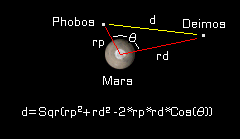
Example:
rp = 9,514.1 km
rd = 23,462.9 km
θ = 7°
d = 14,044.7 km
13. Light Distance
To compute the time the light travels from one object to another:tl = a / 7.2143597285175 [hrs]
where...
a = distance [AU]
7.214... speed of light [AU/hour]
Given a distance between Mars and Earth of, for example, 0.8142AU, the light time between the two planets is 0.1129 hours or 6.7715 minutes.
14. Mars's Polar Axes
Due to the effect of precession and nutation the celestial polar coordiantes of Mars change slightly over time:in right ascension:
317.681° - 0.108T + 0.786T
in declination:
52.886° - 0.061T + 0.413T
with the reference date being 12:00 UT on 1 Jan 2000 (JD 2451545.0) and T the Julian centuries from reference date:
T = (JDnow - 2451545) / 36525
To obtain the south celestial pole reduce the right ascension for north by 12 hours and inverse the declination value.
Example: find the northern coordinates for July 10, 2006 13:27:07 UTC (JD 2453927.060498):
T = (2453927.060498 - 2451545) / 36525
Result: T = 0.065217
RA = 317.681-0.108*0.065217+0.786*0.065217
Result: RA = 317.725°
DE = 52.886-0.061*0.065217+0.413*0.065217
Result: DE = 52.909°
This result reflects the change over 6.5217 years: +0.044° (2.64') in right ascension and + 0.023° (1.38') in declination.
15. Martian Time
Mars Solar Days is an equivalent to the Modified Julian Date, the number of elapsed martian Days (sols) since December 29 1873. While on Earth the prime (null) merdian passes through Greenwhich, the prime meridian defined for Mars passes through a small crater named 'Airy-0' (500 meters across) situated in the larger crater 'Airy' in the Sinus Meridiani region, an albedo feature just south of the equator. A Mars Solar day has 24 hours 39 minutes 35.244 seconds (1 sol) in 24-part divisions. Equivalent to Coordinated Universal Time (UTC) on Earth, the Coordinated Mars Time (MTC) is the time at its prime meridian.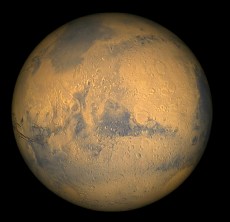
In a computer program, a Mars clock can be easily designed with a line of code:
msd = ((jd - 2451549.5) / 1.027491252) + 44795.9998
where...
jd = Julian date
2451549.5 = jd for 6 Jan 2000 12:00UT
The fractional part of MSD is the MTC: mtc = (msd * 24) Mod 24
Zonal time is obtained by: lmzt = mtc + time zone (such as tz = +9 for Curiosity).
Local Mean Solar Time: lmst = mtc - longitude / 15 (in western longitude, such as 222.55837 for Curiosity)
16. Used Constants
Astronomical Unit1 AU is the mean Earth to Sun distance = 149,597,870.691 kilometers.
Apparent diameter of the Sun
31.9877 arc minutes in 1 AU distance.
Apparent diameter of Earth
17.59 arc seconds in 1 AU distance.
Mars radius
3,398 km on its equator
Phobos Orbit Vector
9,378 km from the center of Mars.
5,980 km from the surface of Mars
(on equator).
Deimos Orbit Vector
23,459 km from the center of Mars.
20,061 km from the surface of Mars
(on equator).
